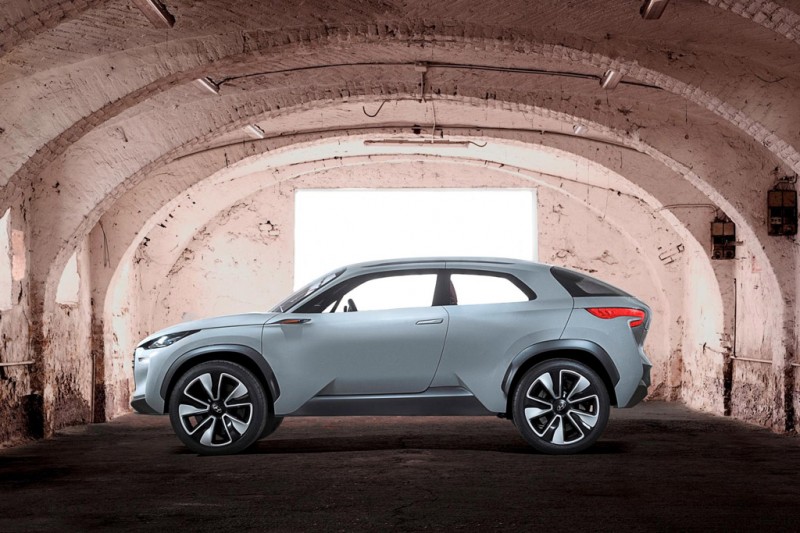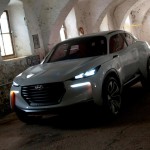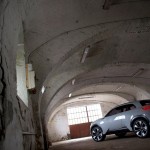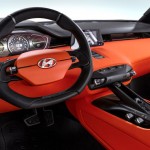In December 2013, Hyundai revealed plans for a new concept car which would be ready for show at this year’s Geneva Motor Show. Named the Intrado, the concept drawing shown in 2013 was but a sketch outlining the rear appearance of the vehicle. Today, Hyundai have taken the wraps off the rest of the car’s unique design and provided some details about how it works too.
Hyundai have stated the Intrado is both a concept car and a vision of the future but is much more than merely an exercise in style. Hyundai’s belief is that advanced vehicle technologies should be better integrated to allow for improved driver/passenger engagement.
Intrado has resulted from fresh consideration of what consumers will need and expect of their cars in the near future: cars that are easy to use, intuitive to interact with, and readily adaptable to the varying demands of their busy, active lifestyles.
Intrado takes its name from the underside of an aircraft’s wing – the area that creates lift. The car’s advanced materials and technologies also draw inspiration from aircraft, such as the removal of all unnecessary weight, logical solutions to complex challenges, inspired by a purity of purpose, and a highly efficient powertrain.
The exterior of Intrado presents a progressive interpretation of Hyundai’s established fluidic sculpture form language. The vehicle’s distinctive shape is dictated by the need to be aerodynamically efficient; it is free of unnecessary adornments and features minimal detailing. The body panels are made of advanced super lightweight steel from Hyundai Motor’s steel plant.
The interior of Intrado is defined by a focus on usability and adaptability, and draws attention to its advanced materials and radical construction to deliver the kind of functional beauty typically seen on high-end mountain bikes. The seals of opening panels shut directly against the central carbon frame, showcasing the carbon fibre whenever doors, hood or trunk are opened. Components that are usually concealed are highlighted, including the ‘see-through’ air vents and exposed frame onto which the seats clip directly. The use of bright ‘Beaufort Orange’ contrasts with the exposed carbon fibre, reflecting the car’s active brief and mirroring its restrained exterior detailing.
The super-lightweight structure of Intrado demonstrates Hyundai’s desire to produce lighter, stronger cars that are even better to drive and simpler to repair. The central carbon frame structure is constructed using new, patent-pending manufacturing and joining techniques that together have the potential to change the way cars are made. The strength and rigidity of this central structure also allow body panels to be constructed from any material, giving designers greater flexibility and aiding repairability. Lightweight steel impact structures further enhance crash performance and repair times.
Intrado is powered by a next-generation hydrogen fuel-cell powertrain that utilises a Li-ion 36 kWh battery. Refuelled in just a few minutes, Intrado has a range of up to 370 miles (approx.600 km) and emits only water. In addition to improved performance and increased range, Intrado promises more responsive and agile driving dynamics, thanks to the reduced weight and greater efficiency of its powertrain.
Intrado is the first Hyundai to have been developed under the direction of Peter Schreyer, who became President and Chief Design Officer of Hyundai Motor Group in January 2013. He commented:
“Effortless and sensual, Intrado reflects the open-mindedness and constant renewal of the Hyundai brand. It also shows that Hyundai wants its customers to rediscover the joy and freedom that should be associated with personal mobility. That’s why this car has such purity of purpose – it’s logical, lovable and liveable.”
The result of close collaboration between Hyundai Motor’s design and engineering teams, Intrado was styled and engineered primarily at Hyundai Motor European R&D centre in Rüsselsheim, Germany – as indicated by its codename, HED-9 (Hyundai Europe Design).
Thomas Bürkle, Chief Designer at Hyundai Motor Europe Technical Centre, led the design team that created the Intrado:
“In line with its promise of a motoring future that is more relevant to users’ lifestyles, we have given Intrado a distinctive exterior and interior shape, formed from the lightweight frame that incorporates only what is necessary. The exterior is defined by a simple yet sporty profile which displays the latest interpretation of fluidic sculpture, while the interior shows how minimal ornamentation will perfectly fit into the varied lifestyles of the millennial generation.”
Source; Hyundai




